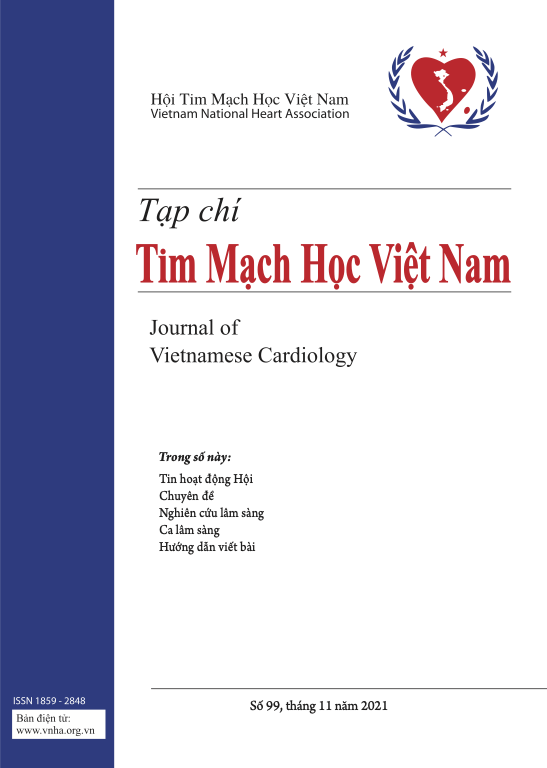Ảnh hưởng của vị trí điện cực thất trái trong tạo nhịp tái đồng bộ tim
Tóm tắt
Ảnh hưởng của vị trí điện cực thất trái trong tạo nhịp tái đồng bộ timTài liệu tham khảo
1. Davis RC, Hobbs FDR, Lip GYH. History and epidemiology. BMJ 2000; 320:39-42.
![]()
2. Ho KKL, Pinsky JL et aỉ. The epidemiology of heart failure: The Frammingham Study. J Am Coll Cardiol 1993; 22: 6A-13A
![]()
3. Haldeman GA, Croft JB, Giles WH et al. Hospitalization of pts with heart failure: National Hospital Discharge Survey, 1985 to 1995. Am Heart J1999; 137: 352-360.
![]()
4. Abraham WT, Fisher WG et al. MIRACLE study group. Multicenter InSync Randomized Clinical Evaluation. Cardiac resynchronization in chronic heart failure. N Engl J Med 2002; 346:1845-1853.
![]()
5. Abraham WT, Young JB et al. Effects of cardiac resynchronization on disease progression in patients with left ventricular systolic dysfunction, an indication for an implantable cardioverter-defibrillator, and mildly symptomatic chronic heart failure.. Circulation2004; 110:2864-8.
![]()
6. Bristow MR, Saxon LA et al. Comparision of Medical Therapy, Pacing and Defibrilation in Heart Failure (COMPANION) Investigators. Cardiac resynchronization therapy with and without an implantable defibrillator in advanced chronic heart failure. N Engl JMed2004;350:2140-2150.
![]()
7. CazeauS, Leclercq c et al. Multisite Stimulation in Cardiomyopathies (MUSTIC) studyinvestigators. Effects of multisite biventricularpacing in pts with heart failure and intraventricular conduction delay. N Engl J Med 2001;344:873-880.
![]()
8. Cleland JG, Daubert JC et al. Cardiac Resynchronization- Heart Failure (CARE-HF) study investigators. The effect on cardiac resynchronization on morbidity and mortality in heart failure. N Engl J Med 2003;352; 1539-1549.
![]()
9. Linde c, Leclerq c et al. Long term benefirs of biventricular pacing in congestive heart failure: Results from the MUltisite STimulation in cardiacmyopathy (MUSTIC) study. J Am Coll Cardiol. 2002;40:111-118.
![]()
10. Lozano I, Bocchiardo M et al. VENTAK CHF/CONTAK CD Investigators study group. Impact of biventricualr pacing on mortality in a randomized crossover study of pts with heart failure and ventricular arrhythmias. PACE 2000; 23:1711-1712.
![]()
11. YoungJB, Abraham WTetal. Multicenter InSyncICD Randomized Clinical Evaluation (MIRACLE ICD) Trial Investigators. Combined cardiac resynchronization and implantable cardioversion defibrilation in advanced chronic heart failure: MIRACLE-ICD Trial. /AMA2003;289:2685-2694.
![]()
12. Leclercq c, Walker s, Linde c, Clementy J et al. Comparative effects of permanent biventricular and right-univentricular pacing in heart failure patients with chronic atrial fibrillation.. Eur Heart 7 2002;23:1780-7.
![]()
13. Garrigue s, Bordachar p, Reuter s et al. Comparison ofpermanentleft ventricular and biventricular pacing in patients with heart failure and chronic atrial fibrillation: prospective haemodynamic study.. Heart 2002;87:529-34.
![]()
14. Linde c, Abraham WT, Gold MR et al. Randomized trial of cardiac resynchronization in mildly symptomatic heart failure patients and in asymptomatic patients with left ventricular dysfunction and previous heart failure symptoms.. / Am Coll Cardiol 2008;52:1834-43.
![]()
15. Moss AJ, Hall WJ, Cannom DS et al. Cardiac-Resynchronization Therapy for the Prevention of Heart-Failure Events. NEJM 2009)361:1329-1338.
![]()
16. Phuoc XT, Tuoc NN, Hung PN. Preliminary experiences of resynchronization therapy for dilated cardiomyopathy in Vietnam. PACE 2003, Feb, Vol 26, No 2: 818- p S205.
![]()
17. Phạm Như Hùng, Tạ Tiến Phước, Nguyễn Lân Việt. Tái đổng bộ tim điểu trị suy tim tại Viện Tim mạch Việt Nam. Tạp chí Tim mạch học Việt Nam. 2008 Số 50:15-24.
![]()
18. Nguyễn Hữu Văn, Đỗ Quang Huân, Phạm Nguyễn Vinh. Kết quả bước đầu điểu trị tái đổng bộ bằng tạo nhịp 2 buổng thất tại Viện Tim TP. Hổ Chí Minh. Chuyên để tim mạch. 2012; Tháng 1:9-12.
![]()
19. Huỳnh Văn Minh, Nguyễn Văn Điền, Hoàng Anh Tiến. Bước đẩu áp dụng phương pháp tái đổng bộ trong điểu trị suy tim tại Bệnh viện Đại học Y Dược Huế. Tạp chí Tim mạch học Việt Nam 2011; Số 59: 367-372.
![]()
20. Epstein EA, DiMarco JP et aỉ. ACC/AHA/HRS 2008 guidelines for Device-Based therapy of cardiac Rhythm Abnormalities.; JACC .2008;21:1-62.
![]()
21. Singh JP, Houser s et al. The Coronary Venous Anatomy. A segmental approach to aid cardiac resynchronization therapy. JACC 2005;46:68-74.
![]()
22. Heist EK, Fan D, Mela T et al. Radiography left ventricular- right ventricular interlead distance predicts the acute hemodynamic respone to cardiac resynchronization therapy. The Am J Cardiol-, 2005: 96:685.
![]()
23. Chung ES, Leon AR, T avazzi L et al. Results of the Predictors of Response to CRT (PROSPECT) Trial. Circulation 2008; 117;2608-2616
![]()
24. Dickstein K, Bogale N, Priori s et al. The European cardiac resynchronization therapy survey. Eur Heart J 2009;30:2450-2460.
![]()
25. Hanky B, Schulte ES, Vogt J et al. Lead selection and implantation technique for biventricular pacing. Eur Heart /; 2004; 6: D112-116.
![]()
26. Gasparini M, Mantica M, Galimberti p et al. Is the left ventricular lateral wall the best lead implantation site for cardiac resynchronization therapy? PACE 2003;26:162-8.
![]()
27. Saxon LA, Olshansky B, Voỉosin K, Steinberg JS et al. Influence of left ventricular lead location on outcomes in the COMPANION study. J Cardiovasc Electrophysiol. 2009;20:764-768.
![]()
28. Derval N, Steendijk p, Gula LJ, et al. Optimizing hemodynamics in heart failure patients by systematic screening of left ventricular pacing sites: the lateral left ventricular wall and the coronary sinus are rarely the best sites. J Am Coll Cardiol. 2010;55:566-575.
![]()
29. Moss AJ, Hall WJ, Cannom DS, et al. MADIT-CRT Trial Investigators. Cardiac-resynchronization therapy for the prevention of heart-failure events. N Engl J Med; 2009; 361:1329-38.
![]()








